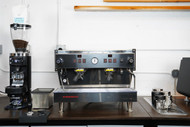For coffee lovers around the world, espresso machines have become an iconic symbol of coffee culture. It is an essential piece of equipment found in cafes, restaurants, and homes, providing the perfect shot of espresso to start the day or to enjoy as a mid-day pick-me-up.
You might have a very particular image that comes into mind when you think of an espresso machine, even if you’ve never worked as a barista.
How did espresso machines become so iconic? Keep reading below to find out!
(Pictured below: La Marzocco Linea Classic S, Auto-Volumetric)

History of the Espresso Machine
The invention of the espresso machine dates back to the late 19th century when Luigi Bezzera, an Italian inventor, created a machine that used steam to force hot water through ground coffee. This early version of the espresso machine was not very efficient and produced inconsistent results, but it paved the way for further development of the technology.
In the early 20th century, Achille Gaggia, another Italian inventor, introduced a new type of espresso machine that used a lever to create pressure and force water through the coffee. This method, known as the "crema" style, produced a thicker, more flavorful espresso with a frothy layer on top that became a hallmark of the drink.
As the popularity of espresso grew, so did the demand for espresso machines, and companies like La Pavoni, Faema, and La Marzocco began producing high-quality espresso machines that could make multiple shots of espresso quickly and consistently. These machines became a fixture in cafes throughout Europe, and soon the rest of the world.
Today, espresso machines come in a variety of styles and sizes, from small countertop machines designed for home use to large commercial machines capable of producing hundreds of shots per hour. The La Marzocco Linea, for example, comes in a variety of commercial, Mini, and even Micra models!
[dib_prod_2629]
But it's not just the technology that has made the espresso machine iconic. It's also the ritual and culture that surrounds it. From the sound of the grinder to the hiss of the steam wand, making espresso is a sensory experience that engages all five senses.
For many people, the act of preparing and savoring a shot of espresso has become a daily ritual, a way to connect with friends and colleagues, or simply a moment of quiet reflection in a busy day. A large portion of the population has also worked behind the bar, pulling shots of espresso themselves, and becoming intimately familiar with the tools of the trade. They know that a quality espresso machine can carry the performance (and price) of a small car.
Since it will be front and center in a cafe, often being the center of the operational universe, your espresso machine must be beautiful as well as functional. The La Marzocco Linea Classic S has been produced for many years, upgrading the internal functionality, while maintaining a consistent outer appearance.
[dib_prod_2455]
Espresso machines have become an iconic symbol of the coffee culture due to its history, technology, and the ritual and culture that surrounds it. The aesthetics of machines from La Marzocco, Kees Van Der Westen, and Slayer Espresso embody the luxury and performance we’ve come to expect.
[dib_prod_517]
Espresso has brought people together and become an essential part of our daily lives. Whether enjoyed at a café or made at home, the perfect shot of espresso is a thing of beauty and a true testament to the art and science of coffee-making.
Brew Your Best!


